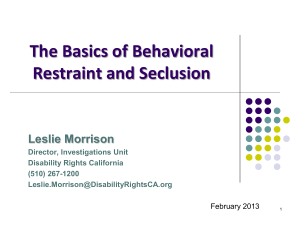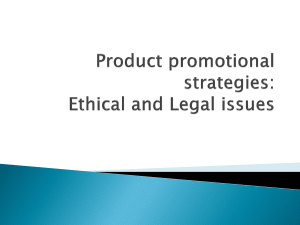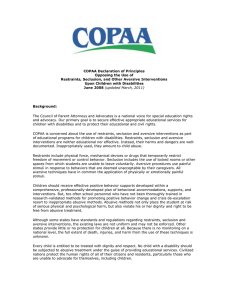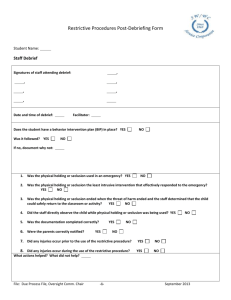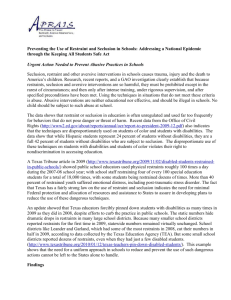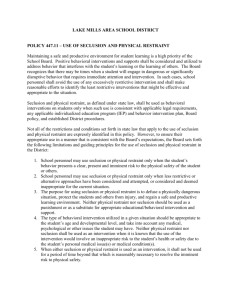Chapter 9 Legal and Ethical Issues
advertisement
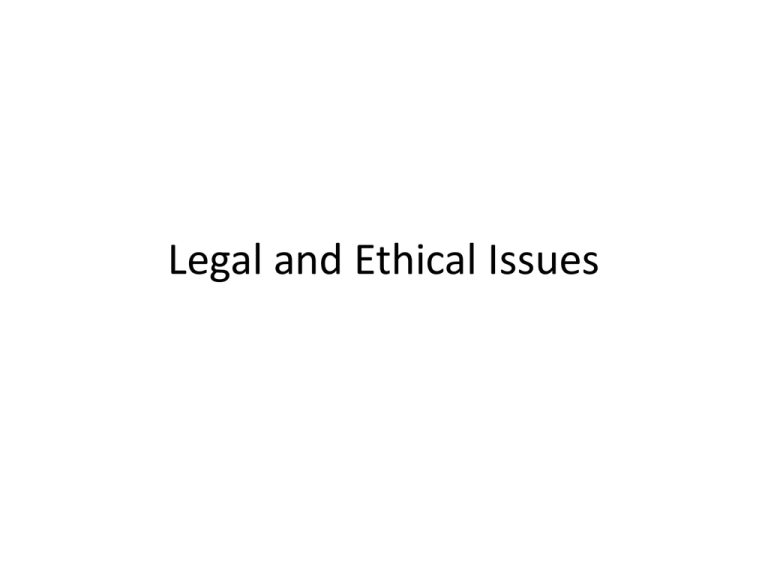
Legal and Ethical Issues Learning Outcomes • Describe the rights of the patient in a psychiatric setting. • Describe the types of admissions of patients on a mental health unit. • Discuss the legal and ethical issues of seclusion and restraints. • Identify the legal terms pertinent to psychiatric nursing. • Explain the meaning of standard of care. Rights of Patient’s Mental health patients retain all civil rights afforded to all people except the right to leave the hospital in the case of involuntary commitment Bill of Rights Chapter 9 • Least restrictive environment- at home, hospital if possible. • Confidentiality- HIPAA, pt gives code for callers they allow, release of info signed • Access to attorney/courts- 24-7, private rm for meeting, can go to court if feel held against will • Access to belongings- shampoo, clothes- in bends • Informed of rights- know why they r there, meds • Refuse medications/treatment • Visitors- at visiting hours, certain limited • Telephone- with some limits • Writing materials/uncensored mail- in certain areas- open in front of case worker or nurse Types of Admissions • Voluntary admission- patient is agreeable to in house treatment • Involuntary admission- patient admitted without their consent through legal processes Involuntary Admissions To retain without the right is false imprisonment Magistrate’s order – check chart to understand what’s going on for the admission 1) Evaluation/emergency care (ED) –form filled out by police/others; usually for 48 to 72 hours- gives time to assess & find illness (UTI)/mental 2) Order of protective custody (OPC)- legal papers filed in court; vary from days to weeks – 2 different drs have assessed & court decides to lock up – 7d to 14d pt must be released after the time/OPC is up. 3) Extended/indeterminate care- legal system involved; long term; may be 30-90 days 4) Magistrates warrant – legal sworn statement issued about a patient through judge, by a family member, signs document that pt is incompetent. Involuntary Hospitalization • Laws are determined by each state; know the laws of the state where you practice • Persons detained in this way lose only the right to freedom; all other rights are intact • Persons held without their consent must present an imminent danger to themselves or others Release From the Hospital • Patients hospitalized voluntarily have the right to request discharge at any time and must be released unless they represent a danger to themselves or others; if such a danger is present, then commitment proceedings must be instituted to keep them in the hospital • Patients who are no longer dangerous must be discharged from the hospital Mandatory Outpatient Treatment • Requires that patients continue to participate in treatment on an involuntary basis after their release from the hospital into the community • Examples include taking prescribed medications, keeping appointments with healthcare providers for follow-up, and attending specific treatment programs or groups Conservatorship • Legal guardianship is separate from civil commitment for hospitalization • A hearing can be held to determine whether the person is competent. An incompetent patient cannot provide his or her own shelter, food, and clothing; cannot act in his or her own best interests; and cannot run his or her own business and financial affairs. If a patient is found incompetent, a guardian is appointed to speak for the patient. Competency • An incompetent patient can no longer: – Enter into legal contracts with a signature – Sign checks – Use a credit card – Make a will – Open bank accounts – Sell property – Get married – Give consent for surgery ***Least Restrictive Environment Legal- file suite- keeping them & they don’t want to be kept • Treatment must be provided in the least restrictive environment appropriate to meet the patient’s needs • Physical restraint or seclusion (assess 1st- take high priority) in a locked room can be used only when the person is imminently aggressive or threatening to harm himself- hit or threatened someone then use this methods – Any pt in seclusion or restraints take high priority Least Restrictive Environment (cont’d) • Restraint and seclusion, if used, must be in place for the shortest time necessary • Many regulations govern the monitoring of clients in seclusion or restraint for their safety Restraints/Seclusion • Restraint: application of force without the patient’s permission (human, mechanical, chemical) • Seclusion: involuntary confinement in specially constructed, locked room equipped with security window or camera Restraints/ Seclusion • Face to face evaluation in 1 hour, every 8 hours • Physician’s order every 4 hours • Documented assessment by nurse every 1-2 hours • Close supervision of patient • Debriefing session within 24 hours after release from restraint or seclusion Confidentiality • Regulated by the Health Insurance Portability and Accountability Act (HIPPA) of 1996 • Both civil (fines) and criminal (prison sentences) penalties exist for violation of patient privacy • If the pt states that after discharge they plan to take an overdose of meds… The nurse must advise the team/phys know. Duty to Warn Third Parties Do have the right to warn the person that is being threatened – error on the side of safety • Duty to warn a third party is an exception to client confidentiality • Clinicians must warn identifiable third parties of threats made by a client • Is the client dangerous to others? • Is the danger the result of serious mental illness? • Is the danger serious? • Are the means to carry out the threat available? • Is the danger targeted at identifiable victims? • Is the victim accessible? Nursing Liability • Nurses are expected to meet standards of care developed from: – ANA’s Code of Ethics for Nurses with Interpretive Statements – ANA’s Scope and Standards of Psychiatric-Mental Health Nursing Practice – State nurse practice acts – Federal agency regulations – Agency policies and procedures – Job descriptions – Civil and criminal laws Tort: A wrongful Act That Results in Injury, Loss, or Damage Have to watch what say & do – assault & battery Unintentional Torts – Negligence: harm caused by failure to do what is reasonable and prudent – Malpractice: breach of duty directly causes injury or loss to the client Intentional Torts – Assault: causes person to fear being touched in an offensive manner) – Battery: harmful or unwanted actual contact) – False imprisonment: unjustifiable detention Prevention of Liability DOCUMENT any unusual events so that if you have to go to court you have notes to refresh what occurred Nurses can minimize the risk of lawsuits through safe, competent nursing care and descriptive, accurate documentation Ethical Principles Knowing rules & policies on the floor you are working is key Autonomy: right to self-determination and independence Beneficence: duty to benefit others or promote good Nonmaleficence: do no harm Justice: fairness Veracity: honesty, truthfulness Fidelity: honor commitments and contracts Ethical Dilemmas in Mental Health • Ethical dilemma is a situation in which ethical principles conflict or there is no one clear course of action. • Many dilemmas in mental health involve the client’s right to self-determination and independence (autonomy) and concern for the “public good” (utilitarianism) • ANA Code of Ethics for Nurses guides choices about ethical actions Ethical Decision-Making • Ethical decision-making includes: – Gathering information – Clarifying values – Identifying options – Identifying legal considerations and practical restraints – Building consensus for the decision reached – Reviewing and analyzing the decision Self-Awareness Issues • Talk to colleagues or seek professional supervision • Spend time thinking about ethical issues and determine what your values and beliefs are regarding situations before they occur • Be willing to discuss ethical concerns with colleagues or managers





